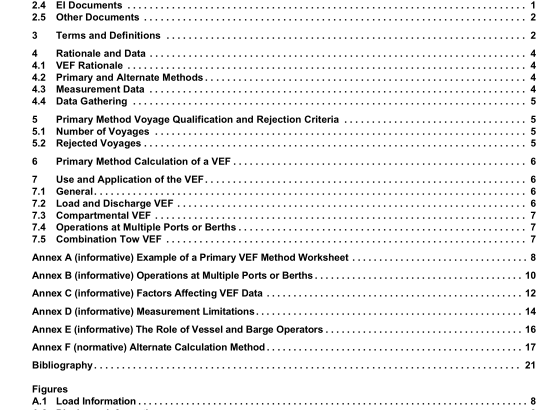API MPMS 17.9:2007 pdf free download.Manual of Petroleum Measurement Standards Chapter 17.9 Vessel Experience Factor (VEF) El Hydrocarbon Management HM 49
4 Rationale and Data
4.1 VEF Rationale The VEF is a loss control tool that can help determine whether differences measured between the vessel and the shore are typical. The VEF may then provide a reliable means for review of quantities loaded or discharged and provide meaningful cargo reconciliation. As a result of differences between load and discharge operations, the load and discharge VEFs will not typically have the same values and therefore the load and discharge data shall be maintained separately. When agreed by interested parties, Bill of Lading or outturn quantities may be determined based on vessel received or delivered quantities adjusted by the VEF. In the event of a dispute regarding the application of a VEF, resolution shall be made by the commercial parties involved.
4.2 Primary and Alternate Methods This standard provides a primary method for calculating a VEF. The primary method uses ±0.30 % of the mean vessel/shore ratio for outlier rejection and is the ratio of the sum of all qualifying voyages. See Annex A. If the primary method does not produce a VEF, then the alternate method should be used. The alternate method provides a statistical outlier rejection technique and uses an average of qualifying ratios. See Annex F.
4.3 Measurement Data All measurement data used must be based on globally recognized measurement standards for custody transfer purposes. Ship and shore calculations for each VEF line entry shall be based upon the same measurement standards. Cargo calculations and factors such as volume correction factors (Ctl), ROB/OBQ determinations, wedge calculations, and trim/list corrections should be consistent. NOTE Where TCV is stated in this standard, its weight equivalent may be used, as appropriate. TCV calculated using non-petroleum products will still be considered for this standard.
4.4 Data Gathering Data required for VEF calculation should be collected and recorded by the vessel or barge operator for every voyage. The data should be in a clear, understandable format, as illustrated in the sample log presented in Annex A. The vessel is responsible for maintaining separate logs for both load and discharge operations and for making these records available to the inspector. When vessel records are unavailable or incomplete, data may have to be compiled from inspection company records or other independent sources. Data that are not provided by the vessel or independent inspection companies can only be used if agreed to by the commercial parties.
5 Primary Method Voyage Qualification and Rejection Criteria
5.1 Number of Voyages
The most recent 20 voyages shall be used, or as many as are available, up to a maximum of 20.
The vessel shall maintain data to support the calculation of the VEF. See example in Annex A. These data include:
a) Load (or discharge) date
b) Voyage number
c) Port (or ports for a multi-port voyage)
d) Cargo description
e) Vessel sailing TCV (or Vessel Arriving TCV)
f) OBQ TCV (or remaining on board TCV)
g) Vessel loaded (or vessel discharged)
h) Shore load TCV (or shore discharge TCV): this quantity shall be on a consistent CTPL basis with vessel TCV quantities listed above
i) Load B/L basis (or discharge basis)
j) Comments (as applicable)
All voyages shall be listed in sequential order, with the most recent voyage first. The current voyage shall not be included. Any multi-port/multi-grade voyages shall be combined prior to adding to the list and a comment added to the worksheet to reflect this combination of ports into a single entry.
5.2 Rejected Voyages
The following voyages shall not be used in the calculation:
a) Gross error voyages
b) Voyages where only vessel tank measurements were available (i.e. vessel-to-vessel transfers, active shore tanks) except where quantities are determined onboard FPSOs using meters in accordance with globally recognized standardsAPI MPMS 17.9 pdf download.API MPMS 17.9:2007 pdf free download
